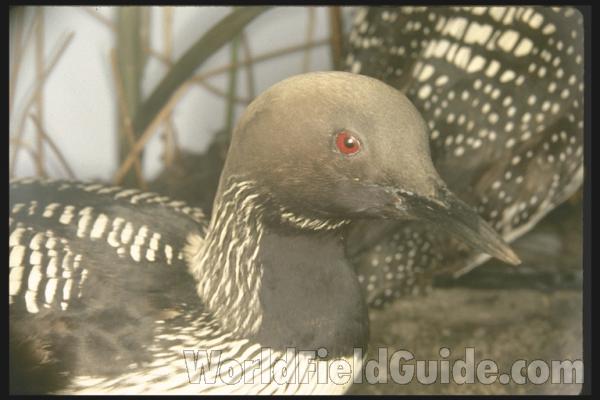SPECIES INFO
Pacific Loon (Gavia pacifica also called G. arctica) is found in northern Eurasia and Alaska. This species winters in India and on the west coast of North America as far south as Mexico. This also winters in Japan. The gray head and small size, typically twenty-five inches, help identify this black and white bird.
There are no subspecies.Loon genus (Gavia) contains five species of birds. Loons are known for their unusual songs which include wailing, laughing, and other unusual sounds. The sexes are similar in both size and color. In late summer their colors fade, and the species are difficult to tell apart by winter.
Loons (Family Gaviidae) are a group of ancient birds that are found primarily in the northern regions of both the Old and New World. Although the legs of the loons are almost useless on land, their webbed feet make them among the finest swimmers known. It is estimated that loons can dive to depths over 200 feet, and their special body chemistry lets them stay under water for several minutes if needed. Loons have small wings, and have trouble taking off. Water is usually required to get them into the air. There were four species of loons as of 1960. However, recent study has increased the number of living loon species to five.
Some modern authors have moved the loon family into the Ciconiiformes order of birds which includes many of the shorebirds.
Loons (Order Gaviiformes) are a group of ancient birds that are found primarily in the northern regions of both the Old and New World. Although the legs of the loons are almost useless on land, their webbed feet make them among the finest swimmers known. It is estimated that loons can dive to depths over 200 feet, and their special body chemistry lets them stay under water for several minutes if needed. Loons have small wings, and have trouble taking off. Water is usually required to get them into the air. There were four species of loons as of 1960. However, recent study has increased the number of living loon species to five.
Some modern authors have moved the loon family into the Ciconiiformes order of birds which includes many of the shorebirds.
Aves contains about 8,650 different species of living birds known to science. Each year about one new species is discovered in some remote rain forest or remote island. In addition, scientists have been raising many subspecies to full species status which may raise the species count to 10,000. Birdlife recognizes 10,027 species as of 2011.
However, each year about one species goes extinct. The rate of extinction is increasing, and the rate of new discovery is decreasing, so that the number of bird species will soon begin to decline rapidly. Although different taxonomists would organize the birds differently, there are approximately twenty-seven orders of birds. These orders are broken down into about one hundred and fifty-five different families.
Recent research of the genetic structure of some of the shore birds and owls would indicate that the present organization of orders and families should have some modification.
The birds are a worldwide group of animals that are characterized by having the front limbs modified into wings that are used for flying. Perhaps the most unique feature of the birds is the feathers. These feathers are made up of a central support called a quill and a series of small filaments that are hooked together as barbs.
For many years it was believed that Archaeopteryx discovered in Bavaria was the oldest bird from about 150 million years ago. However, in l986, Sankar Chattterjee, a Texas paleontologist, reportedly discovered a bird in the genus Protoavis that lived about 225 million years ago.
When this project was begun in 1978, we used Austin & Singer for bird taxonomy. Since then, we have adopted many changes, but have kept some older concepts that are still found widely in the literature. Recently, we have used Clements and Howard & Moore. Very recently, we have used Monroe and Sibley for the higher taxonomy of the perching birds.
Backboned Animals (Phylum Chordata) are the most advanced group of animals on earth. These animals are characterized by having a spinal cord or backbone. Most members have a clearly defined brain that controls the organism through a spinal cord. Fish, amphibians, reptiles, birds, and mammals are in this phylum.
Currently, some taxonomists believe that the fish should be divided into two groups (sharks and regular fishes) and that there are some other primitive groups in the phylum such as hagfish or lampreys.
Animal Kingdom contains numerous organisms that feed on other animals or plants. Included in the animal kingdom are the lower marine invertebrates such as sponges and corals, the jointed legged animals such as insects and spiders, and the backboned animals such as fish, amphibians, reptiles, birds, and mammals.


